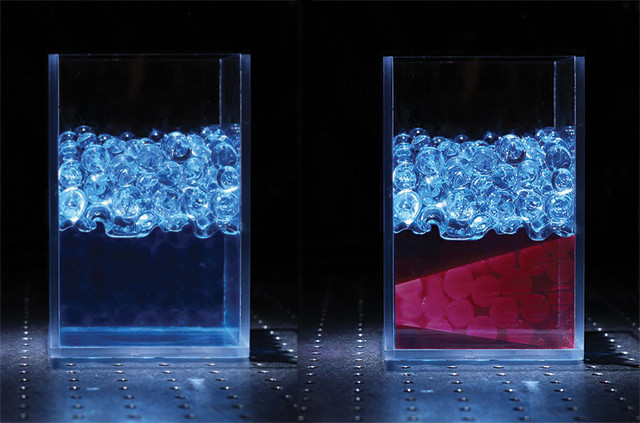
by Julia Rosen Tuesday, June 16, 2015

Researchers used beads filled with laser-activated dye to reveal the behavior of granular materials during landslides. Credit: Felice Frankel and Joshua Dijksman.
How does cereal pour from the box? Why do grains of wheat become wedged inside a hopper? What happens to soil when a slope collapses in a landslide? And, more broadly, what do these diverse phenomena have to do with each other?
The answer is that they’re all governed by the same laws of physics, those that control the behavior of granular materials. A detailed understanding of these laws has eluded physicists for centuries. But now, researchers working in the lab have developed a new way to explore the mathematical relationships that underpin particle interactions. The results may one day help explain the mechanics of avalanches, landslides and myriad other geophysical and industrial processes.
Ever since Stephen Hales studied the packing pattern of peas in 1727, physicists have sought a way to relate what happens on a small scale between two particles — which is relatively easy to measure — to what happens on a large scale between many particles — which is not. Such equations for materials like liquids and solids “have been around for 100 or more years, and they work great,” says Robert Behringer, a physicist at Duke University and a co-author of the study, published in Nature Communications. But there is no well-accepted model for granular materials.
So Behringer and two former post-doctoral fellows at Duke, Nicolas Brodu and Joshua Dijksman, combined their laboratory and data visualization skills to create an experiment that would let them study complex, multiparticle interactions in exceptional detail. They started with roughly 500 marble-sized hydrogel spheres filled with a laser-activated dye and stuffed them into a case the size of a tissue box. Then, they used a plate to slowly compress the beads from above, like a garbage compactor.
To image what happened during the experiment, the team shone a flat laser beam through the box, which illuminated a cross-section of beads. They swept the laser back and forth, snapping photos and then stitching them together to create a 3-D image, like an MRI. By scanning the box repeatedly as the experiment progressed, the researchers could watch how the particles deformed and reorganized as the pressure bearing down on them increased.
It’s well known that granular materials get stiffer with compression (think of how a sand beach feels solid under your feet, but easily crumbles between your fingers). The experiment revealed why: Some of the stiffness comes from deforming individual grain boundaries, but they can only give so much. In addition, the number of contacts between grains also increases, Behringer says. “As more contacts form, the system can resist additional compression,” he explains. Such insights will help researchers formulate equations that describe the physics of granular systems.
Although previous studies have employed similar techniques — like imaging particles or compressing beads — none have combined these methods into one experiment, says Brian Tighe, a physicist at the Delft University of Technology in the Netherlands, who was not involved in the work. Tighe says the new results are fundamental — “it’s not work that’s going to immediately tell you when a landslide will start” — but they will help scientists test their models in ways that haven’t been possible until now. If your model performs well in these basic situations, he says, “you trust it a lot more” when it simulates geophysical processes like landslides and avalanches. In the end, what’s really novel about this study, Tighe says, is that “they’ve made something invisible visible.”
© 2008-2021. All rights reserved. Any copying, redistribution or retransmission of any of the contents of this service without the expressed written permission of the American Geosciences Institute is expressly prohibited. Click here for all copyright requests.